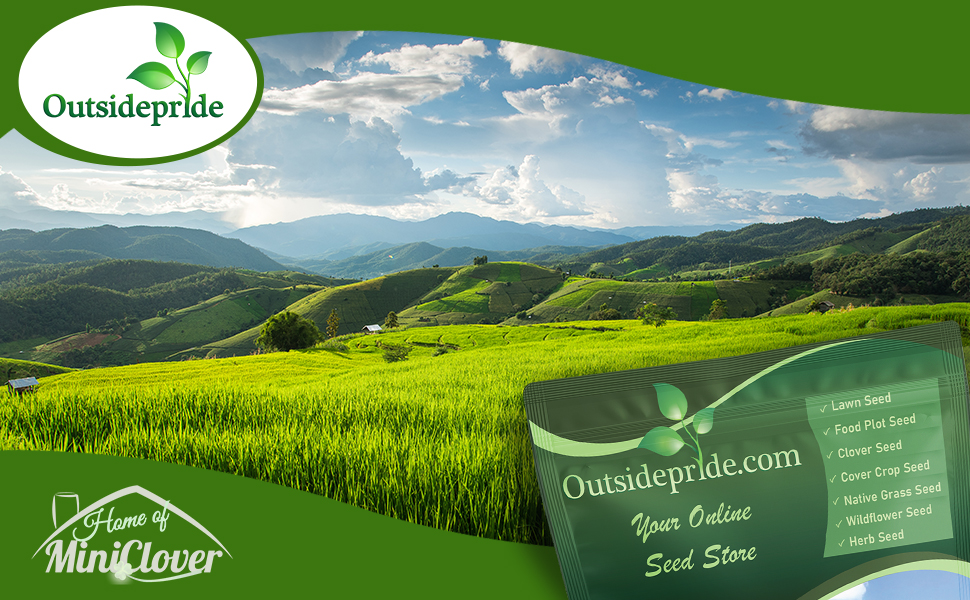Grass Specifications:
Season: Perennial
USDA Zones: 3 - 9
Environment: Full sun
Height: 36 - 60 inches

Outsidepride Perennial Switchgrass is a hardy native North American grass that thrives in diverse conditions, making it an excellent choice for ornamental landscaping or erosion control. Reaching 3 to 5 feet with leaves reaching up to 2 feet, this perennial grass features striking blue-green leaves and reddish stems, adding visual interest to any garden. It is incredibly resilient, tolerating poor soils, drought, and flooding, and requires minimal maintenance once established. With its ability to withstand challenging environments, switchgrass is an attractive addition to gardens and a greener option for areas prone to erosion. It is available in 4 different sizes to suit your landscaping needs.
Outsidepride Switchgrass native grass seed thrives in dry conditions, similar to Indian grass seed. Our deep-rooted grass taps into moisture deep below the surface, ensuring lush growth even in drought-prone areas. Ideal for fields, slopes, or open spaces, switch grass remains vigorous and green, reducing the need for supplemental watering.
Switchgrass seed excels in poor soils, adapting to a range of conditions like buffalo grass seed and bahia grass seed. This hardy grass seed flourishes where others fail, establishing strong roots in sandy, clay, or low-nutrient soils. Whether you're working with challenging terrain or depleted lands, switchgrass provides reliable coverage and growth.
Using Switchgrass native grass seed is a low-maintenance solution, ideal for those seeking a self-sufficient landscape. It requires minimal care—no frequent mowing, fertilization, or watering. Plant it and watch it thrive, growing tall and dense with little intervention, providing a visually appealing and functional landscape.
Switchgrass is highly effective for erosion control. Our deep-rooted grass stabilizes soil, reducing runoff on slopes and riverbanks. The robust root system holds the ground in place, preventing soil loss and promoting healthier landscapes, much like perennial grass seeds. Ideal for areas prone to erosion, switchgrass ensures long-term stability.

Switchgrass is an exceptional choice for challenging conditions, thriving where other plants struggle. Often found along natural water features, it excels in fields with sandy loam soils, making it a versatile option for various landscapes. This resilient grass boasts an aggressive growth habit, enhanced drought tolerance, and a remarkable ability to survive flooding. Its adaptability also extends to livestock potential, offering nutritious forage when grazed before seed stalks develop. Whether managing fields or enhancing pastures, switchgrass is a robust, low-maintenance solution that thrives in tough environments.

Switchgrass goes beyond farming, serving as a versatile raw material product like paper, packaging, and bioplastics. Our switchgrass seed provides a friendly solution supporting industries focused on responsible production. This multifunctional grass not only aids agriculture but also contributes to reducing waste and promoting green manufacturing practices, making it a key resource in the push for a greener, more responsible future.

Outsidepride Switchgrass Native Grass Seed is easy to establish with the right techniques, whether you're planting for ornamental purposes, pastures, or a food plot. Use 1/2 to 1 pound of pure live seed (PLS) per 1000 square feet, or 8-12 pounds of PLS per acre. The optimal seeding depth is 1/2 to 3/4 inch, and the best time to sow is in spring when soil temperatures reach 60°F. Techniques like broadcast seeding, followed by light raking or dragging, ensure even distribution and successful germination, making switchgrass a reliable choice for robust growth and resilience.
Switchgrass (Panicum virgatum) is a summer perennial grass that is native to North America. It is a natural component of the native tall-grass prairie which covered most of the Great Plains, as well as the south and eastern United States. This native grass grows best in areas that receive 30 inches of rainfall a year or in irrigated areas with average to wet soils. It is resistant to many pests and plant diseases, and it is capable of producing high yields with very low applications of fertilizer. This means that the need for agricultural chemicals to grow switchgrass is low to non-existent. Switchgrass also is very tolerant of poor soils, flooding and drought.
Switchgrass usually grows 3 to 5 feet in height. Even as a seedling, it can be distinguished from other native grasses by the dense patch of hairs at the point where the leaf blade attaches to the sheath. The stem is round and usually has a reddish tint. The seed head (panicle) is spreading and open. Foliage turns a beautiful yellow in fall. Holds its form well throughout the winter and it is also excellent material for fresh and dried arrangements. Used often as an ornamental grass.
When switchgrass is used for pasture it must be grazed before seedstalks develop. Before seedstalks develop, forage quality is high and palatability good. After seedheads emerge, nutrient levels become low and switchgrass becomes unacceptable as pasture. Animals are reluctant to eat mature switchgrass and may refuse it entirely if other feed is available. Begin grazing switchgrass when it becomes ready to graze, regardless of how much grazing potential remains on cool-season pastures. Switchgrass matures earlier than most warm-season grasses, so grazing often needs to begin while cool-season grasses still provide good forage. It is better to graze this native grass when it is ready and then graze the remaining cool-season grass later in the summer, than to finish grazing the cool-season grass first and let the switchgrass become stemmy. If switchgrass becomes stemmy before grazing begins, cut it for hay and graze the regrowth about 45 days later. Deer, quail, turkey, and rabbit also like this native grass.
Switchgrass may be able to play a significant role in improving water quality. It could be planted on highly erodible sites and on field borders. As well, it may be used on sandy soils where excessive nitrate leaching is associated with conventional corn production methods.
8 - 12 PLS lbs per acre or 1/2 - 1 PLS lb per 1000 square feet for ornamental plantings. Switchgrass is most productive on moderately-well to well drained soils of medium fertility and at a soil pH range of 5.5 to 7.0. It can tolerate wet sites and survive short-term flooding.
PLS pounds - Pure Live Seed, or PLS, is the percentage of viable seed in a given lot. It is calculated by multiplying the purity percentage by the total germination percentage. For example, 95% purity multiplied by 85% total germination equals a 80.75% PLS. This means that out of every bulk pound of that bag of native grass seed that you plant, 80.75% of it is actually seed of that tagged variety and has the potential to germinate.

















































